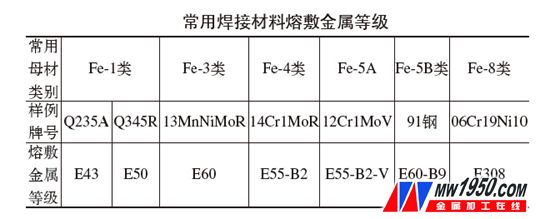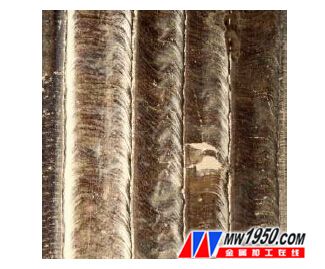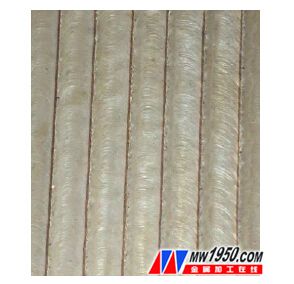Main products and common welding consumables
Our company was founded in June 1954. It designs and manufactures 50~1000MW thermal power generating boilers as the leading products, and designs and manufactures auxiliary equipment, petrochemical containers, nuclear energy equipment, industrial boilers and military products. It has occupied domestically installed thermal power equipment since the founding of the People's Republic of China. With a capacity of more than 35%, the output ranks first in the country. Due to the wide range of products, the variety of base materials, complex structure and high manufacturing difficulty, our company's welding capacity and level are leading domestically, and we have rich experience in localization development and application of welding consumables. The grade of deposited metal for commonly used welding materials is shown in the attached table. At present, nearly 90% of the company's products have achieved localization of welding consumables.

Localization trend
Among some coal and petrochemical products, many of the inner walls of the container are designed with a double-layer stainless steel surfacing corrosion-resistant structure. For products with large casing diameter, thick wall thickness and large-area surfacing stainless steel on the inner wall, the common surfacing method is electroslag surfacing (ESW) or submerged arc welding surfacing (SAW). Although electroslag surfacing (ESW) has the advantages of high deposition efficiency, low dilution rate, narrow welding heat affected zone, etc., it has the disadvantages of shallow penetration, poor resistance to hydrogen stripping, and relatively low bonding strength. The unfavorable conditions for the roundness of the workpiece are out of tolerance, so such products should adopt the method of submerged arc welding surfacing (SAW). For the imported surfacing welding consumables, due to the superiority of its process performance and performance, it once formed a monopoly trend, but it has the disadvantages of high overall cost and long order cycle. With the increasingly fierce competition in the manufacturing market and the need for enterprise survival, the localization of surfacing welding consumables has become the focus of attention of buyers and sellers.
With the development of domestic science and technology and the acceleration of localization, many domestic welding consumables have seen business opportunities and actively strived for technological research and development, and constantly shortened the technological gap with imported welding consumables, and as far as possible in manufacturing costs, transportation and after-sales More favorable conditions have been given, which has broken the situation of imported welding consumables, and has rapidly developed a wide variety of stainless steel welding consumables.
Problems and improvement directions
After a large number of domestic stainless steel welding strip/flux testing and application, our company found that these domestic welding materials have greatly shortened the gap in mechanical properties compared with similar imported materials from abroad, and have more in terms of price and delivery period. Competitive advantage, but at the same time it also summarizes some of the subtle flaws commonly found in domestic welding consumables.
(1) Appearance, packaging and identification issues
   1 Some domestic stainless steel welding strips only have product information such as grades and batch numbers printed on the outer packaging. The inner packaging lacks relevant information. Therefore, once the seal layer and the corrosion resistant layer are not easily identified after unpacking, it is recommended that the welding material manufacturer be in the welding strip. Add a label or logo on the innermost side. 2 Generally, there are obvious traces of grinding treatment at the edge of the imported welding strip, and there are many burrs on the edge of the domestic welding strip, which leads to the smooth feeding of the welding strip. Therefore, it is recommended to add a trimming process before the welding consumables to ensure Safe to use.
(2) Process performance of domestically produced stainless steel strips for submerged arc surfacing
   First, some sintered fluxes have uneven particle size and often fail to meet the lower limit requirements of granularity. They have a "powder surface" shape. The disadvantages are: 1 When used, it is easy to cause welding dust and dust, which leads to environmental pollution. The welder is physically and mentally healthy. 2 The weld bead is ventilated and the slag removal property is poor, and the occurrence of pores and slag on the surface of the weld bead occurs. 3 Once the welding defects are caused, remedial measures such as grinding, repair welding and re-exploration are required, which greatly increases the work intensity of the manufacturing plant, which not only causes waste of manpower and material resources, but also is not conducive to energy conservation and emission reduction, and leads to increased costs. Therefore, it is recommended that the welding material manufacturers strictly implement the standards to ensure the flux supply requirements.
Second, some domestic welding strips/fluxes are found to have frequent defects such as incomplete forming of the weld bead, undercut, poor fusion of the weld bead, difficulty in slag removal and slag removal, etc. (see picture 1). The process performance of imported flux is relatively stable and reliable (see Figure 2). After replacement with the same type of imported flux, the symptoms are basically eliminated to eliminate the possibility of poor weld bead formation (see Figure 3). After analysis, the main reason for this phenomenon may be that some low-melting substances existing in the domestic flux are used to drive the molten iron when the welding slag solidifies when the arc force pushes the liquid metal to the rear and gradually cools and solidifies into a weld bead. As the strip moves forward, it eventually leads to poor bead formation. Therefore, it is recommended that the welding material manufacturers optimize and improve the flux refining process.
  

Figure 1 Domestic welding tape / flux bead

Figure 2 imported solder ribbon / flux soldering

Figure 2 imported solder ribbon / flux soldering

Figure 3 Domestic welding belt / imported flux welding channel
The above problems need to be improved and optimized by the welding material manufacturers, further improve the cost performance of the products, truly achieve high quality and low price, and strive to attract consumers' attention and establish national brands in the new round of localization and introduction of welding consumables.
More exciting content Welcome to Metalworking Online》》》Essen Special Report

The 19th Beijing Essen Welding & Cutting Fair
Shoebox Light Accessories,Shoebox Light Mount Accessories,Led Lighting Shoebox Accessories,Led Street Shoebox Light Accessories
Fuonce-Lighting , https://www.fuoncelighting.com